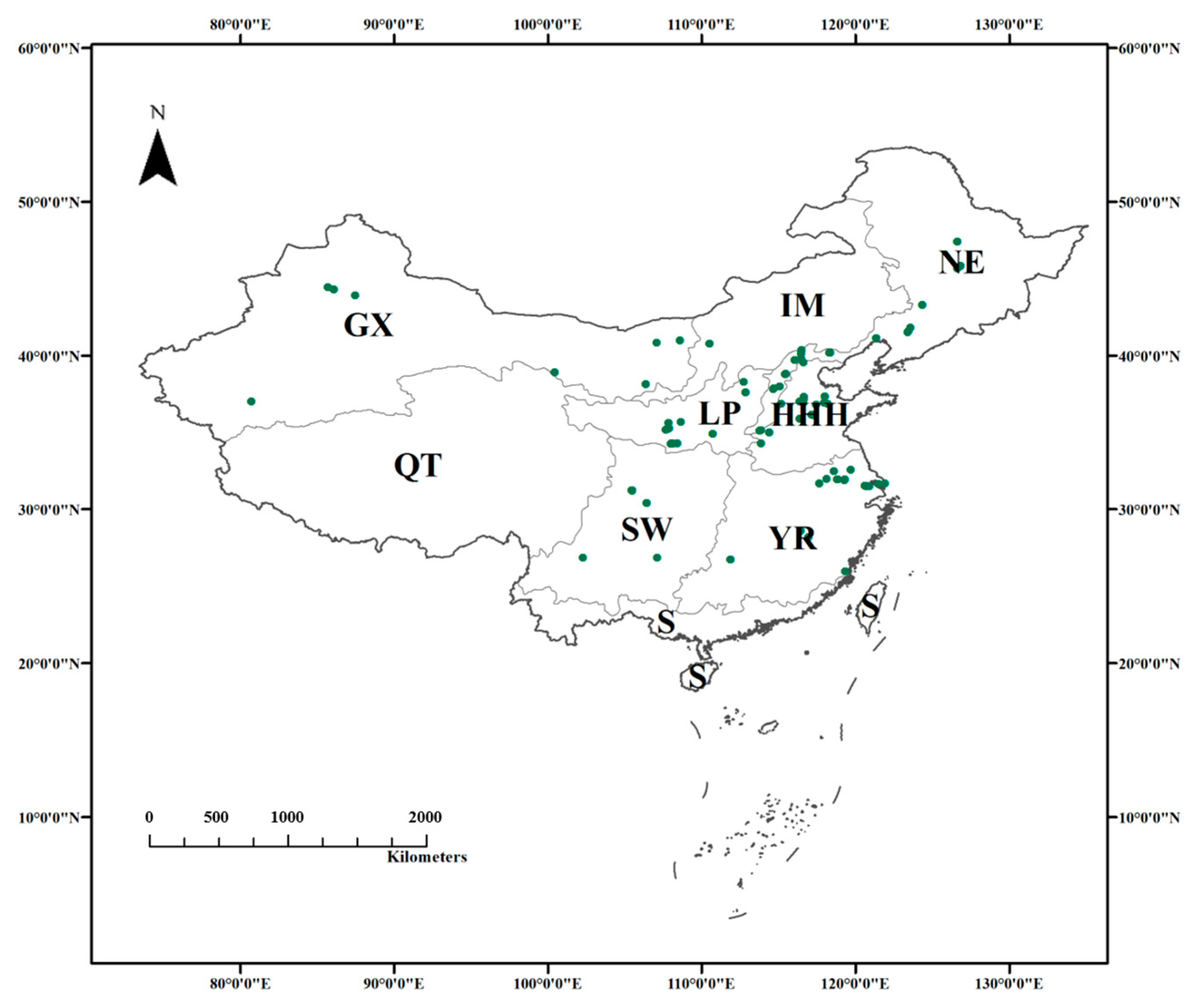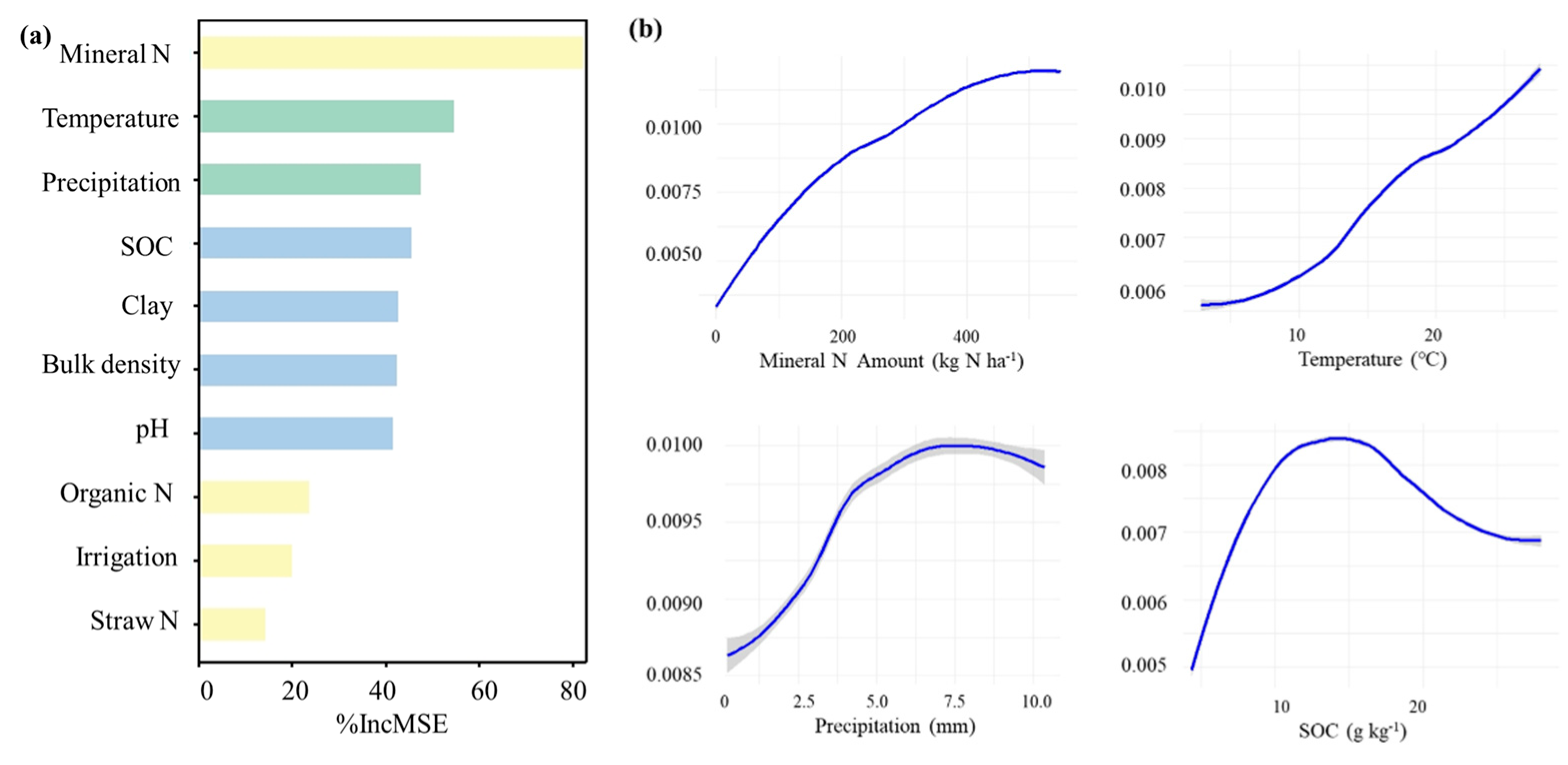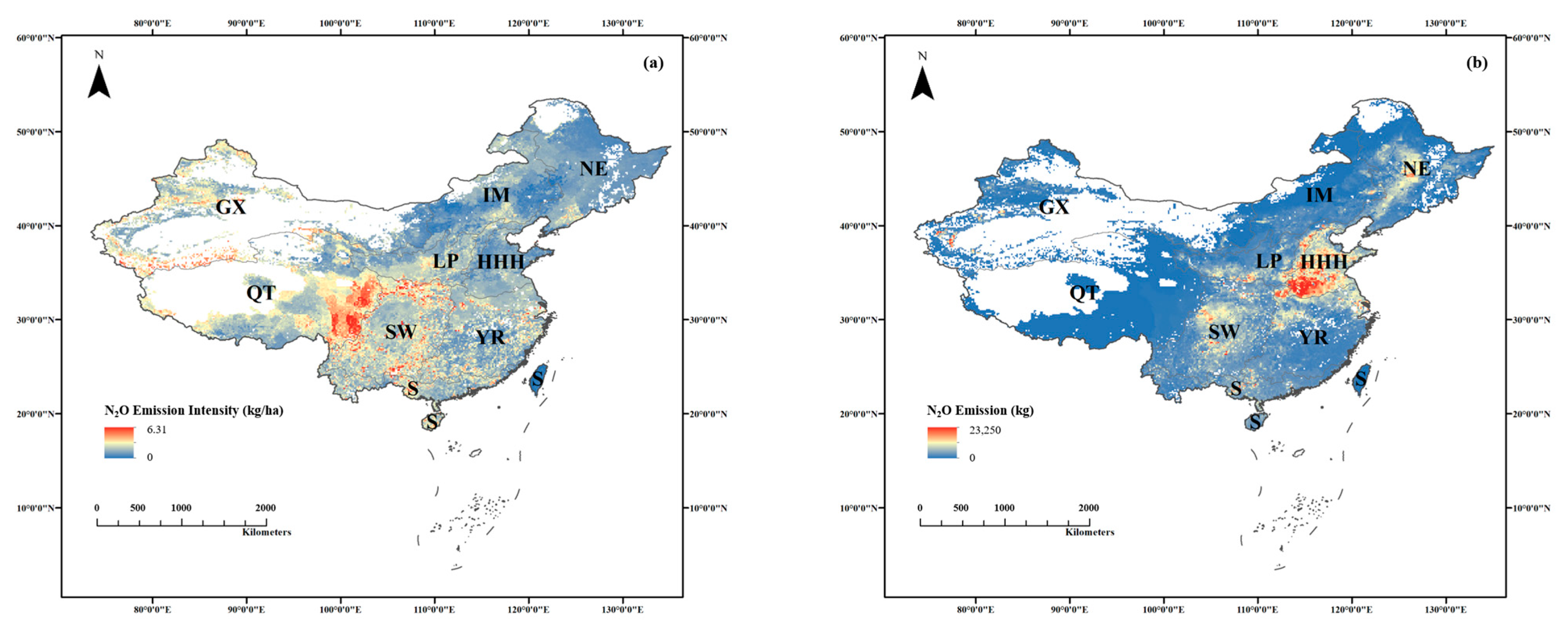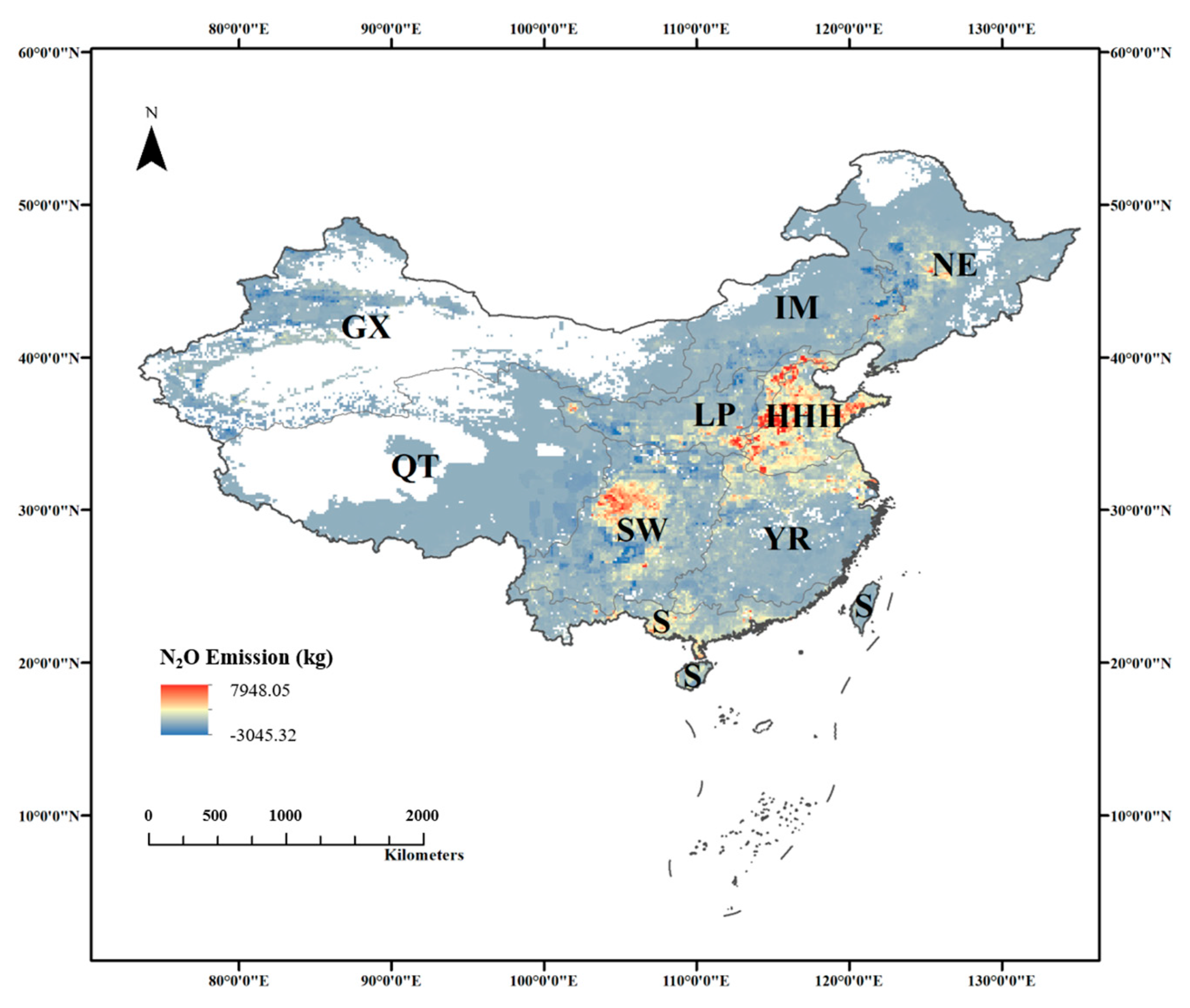Predicting Nitrous Oxide Emissions from China’s Upland Fields Under Climate Change Scenarios with Machine Learning
Abstract
1. Introduction
2. Materials and Methods
2.1. Data Collection for Model Development
2.2. Spatial Database Sources
2.3. Model Development
2.4. N2O Emission Simulation
3. Results
3.1. Model Performance and Interpretability
3.2. N2O Emissions from Upland Fields in 2020
3.3. Impacts of Future Climate Change on N2O Emissions from Upland Fields in China
3.4. Mitigation Potential Under Improved Nitrogen Management
4. Discussion
4.1. Drivers of N2O Emission from Upland Fields
4.2. Characteristics of N2O Emissions and Mitigation Potential
4.3. Uncertainty and Limitations
5. Conclusions
Supplementary Materials
Author Contributions
Funding
Data Availability Statement
Acknowledgments
Conflicts of Interest
References
- IPCC. Summary for policymakers. In Climate Change 2021: The Physical Science Basis. Contribution of Working Group I to the Sixth Assessment Report of the Intergovernmental Panel on Climate Change; Masson-Delmotte, V., Zhai, P., Pirani, A., Connors, S.L., Péan, C., Berger, S., Caud, N., Chen, Y., Goldfarb, L., Gomis, M.I., et al., Eds.; Cambridge University Press: Cambridge, UK, 2021; pp. 923–1054. [Google Scholar]
- Ravishankara, A.R.; Daniel, J.S.; Portmann, R.W. Nitrous oxide (N2O): The dominant ozone-depleting substance emitted in the 21st century. Science 2009, 326, 123–125. [Google Scholar] [CrossRef] [PubMed]
- Paustian, K.; Lehmann, J.; Ogle, S.; Reay, D.; Robertson, G.P.; Smith, P. Climate-smart soils. Nature 2016, 532, 49–57. [Google Scholar] [CrossRef] [PubMed]
- Alexandratos, N.; Bruinsma, J. World Agriculture Towards 2030/2050: The 2012 Revision. 2012. Available online: https://www.fao.org/4/ap106e/ap106e.pdf (accessed on 6 June 2025).
- Liang, M.; Zhou, Z.; Ren, P.; Xiao, H.; Hu, Z.; Piao, S.; Tian, H.; Tong, Q.; Zhou, F.; Wei, J.; et al. Four decades of full-scale nitrous oxide emission inventory in China. Natl. Sci. Rev. 2024, 11, nwad285. [Google Scholar] [CrossRef]
- Shang, Z.; Zhou, F.; Smith, P.; Saikawa, E.; Ciais, P.; Chang, J.; Tian, H.; Del Grosso, S.J.; Ito, A.; Chen, M.; et al. Weakened growth of cropland-N2O emissions in China associated with nationwide policy interventions. Glob. Chang. Biol. 2019, 25, 3706–3719. [Google Scholar] [CrossRef]
- Wrage-Mönnig, N.; Horn, M.A.; Well, R.; Müller, C.; Velthof, G.; Oenema, O. The role of nitrifier denitrification in the production of nitrous oxide revisited. Soil Biol. Biochem. 2018, 123, A3–A16. [Google Scholar] [CrossRef]
- Tian, H.; Yang, J.; Xu, R.; Lu, C.; Canadell, J.G.; Davidson, E.A.; Jackson, R.B.; Arneth, A.; Chang, J.; Ciais, P.; et al. Global soil nitrous oxide emissions since the preindustrial era estimated by an ensemble of terrestrial biosphere models: Magnitude, attribution, and uncertainty. Glob. Chang. Biol. 2019, 25, 640–659. [Google Scholar] [CrossRef]
- IPCC. 2006 IPCC Guidelines for National Greenhouse Gas Inventories; Prepared by the National Greenhouse Gas Inventories Programme; Eggleston, H.S., Buendia, L., Miwa, K., Ngara, T., Tanabe, K., Eds.; IGES: Kanagawa, Japan, 2006. [Google Scholar]
- Smith, K.A.; Mosier, A.R.; Crutzen, P.J.; Winiwarter, W. The role of N2O derived from crop-based biofuels, and from agriculture in general, in Earth’s climate. Philos. Trans. R. Soc. B Biol. Sci. 2012, 367, 1169–1174. [Google Scholar] [CrossRef]
- Xu, R.; Tian, H.; Pan, S.; Prior, S.A.; Feng, Y.; Dangal, S.R. Global N2O emissions from cropland driven by nitrogen addition and environmental factors: Comparison and uncertainty analysis. Glob. Biogeochem. Cycles 2020, 34, e2020GB006698. [Google Scholar] [CrossRef]
- Yue, Q.; Wu, H.; Sun, J.; Cheng, K.; Smith, P.; Hillier, J.; Xu, X.; Pan, G. Deriving emission factors and estimating direct nitrous oxide emissions for crop cultivation in China. Environ. Sci. Technol. 2019, 53, 10246–10257. [Google Scholar] [CrossRef] [PubMed]
- Ma, R.; Yu, K.; Xiao, S.; Liu, S.; Ciais, P.; Zou, J. Data-driven estimates of fertilizer-induced soil NH3, NO and N2O emissions from croplands in China and their climate change impacts. Glob. Chang. Biol. 2022, 28, 1008–1022. [Google Scholar] [CrossRef]
- Bouwman, A.F.; Boumans, L.J.M.; Batjes, N.H. Modeling global annual N2O and NO emissions from fertilized fields. Glob. Biogeochem. Cycles 2002, 16, 28-1–28-9. [Google Scholar] [CrossRef]
- Shcherbak, I.; Millar, N.; Robertson, G.P. Global metaanalysis of the nonlinear response of soil nitrous oxide (N2O) emissions to fertilizer nitrogen. Proc. Natl. Acad. Sci. USA 2014, 111, 9199–9204. [Google Scholar] [CrossRef] [PubMed]
- Zhou, F.; Shang, Z.; Zeng, Z.; Piao, S.; Ciais, P.; Raymond, P.A.; Wang, X.; Wang, R.; Chen, M.; Yang, C.; et al. New model for capturing the variations of fertilizer-induced emission factors of N2O. Glob. Biogeochem. Cycles 2015, 29, 885–897. [Google Scholar] [CrossRef]
- Wang, Q.; Zhou, F.; Shang, Z.; Ciais, P.; Winiwarter, W.; Jackson, R.B.; Tubiello, F.N.; Janssens-Maenhout, G.; Tian, H.; Cui, X.; et al. Data-driven estimates of global nitrous oxide emissions from croplands. Natl. Sci. Rev. 2020, 7, 441–452. [Google Scholar] [CrossRef]
- Yin, Y.; Wang, Z.; Tian, X.; Wang, Y.; Cong, J.; Cui, Z. Evaluation of variation in background nitrous oxide emissions: A new global synthesis integrating the impacts of climate, soil, and management conditions. Glob. Chang. Biol. 2022, 28, 480–492. [Google Scholar] [CrossRef]
- Li, C.; Narayanan, V.; Harriss, R.C. Model estimates of nitrous oxide emissions from agricultural lands in the United States. Glob. Biogeochem. Cycles 1996, 10, 297–306. [Google Scholar] [CrossRef]
- Brown, L.; Syed, B.; Jarvis, S.C.; Sneath, R.W.; Phillips, V.R.; Goulding, K.W.T.; Li, C. Development and application of a mechanistic model to estimate emission of nitrous oxide from UK agriculture. Atmos. Environ. 2002, 36, 917–928. [Google Scholar] [CrossRef]
- Wang, J.; Kuhnert, M.; Abdalla, M.; Smith, P.; Ding, W.; Yan, X.; Zou, J.; Guo, S.; Fan, J.; Jiang, Y.; et al. A Comparison of DNDC and DayCent to Evaluate Greenhouse Gas Emissions from China’s Main Cropping Systems. 2023. Available online: https://ssrn.com/abstract=4354801 (accessed on 6 June 2025).
- Jiang, R.; Yang, J.Y.; Drury, C.F.; He, W.; Smith, W.N.; Grant, B.B.; He, P.; Zhou, W. Assessing the impacts of diversified crop rotation systems on yields and nitrous oxide emissions in Canada using the DNDC model. Sci. Total Environ. 2021, 759, 143433. [Google Scholar] [CrossRef]
- Shaukat, M.; Muhammad, S.; Maas, E.D.; Khaliq, T.; Ahmad, A. Predicting methane emissions from paddy rice soils under biochar and nitrogen addition using DNDC model. Ecol. Model. 2022, 466, 109896. [Google Scholar] [CrossRef]
- dos Reis Martins, M.; Necpalova, M.; Ammann, C.; Buchmann, N.; Calanca, P.; Flechard, C.R.; Hartman, M.D.; Krauss, M.; Le Roy, P.; Mäder, P.; et al. Modeling N2O emissions of complex cropland management in Western Europe using DayCent: Performance and scope for improvement. Eur. J. Agron. 2022, 141, 126613. [Google Scholar] [CrossRef]
- Eckl, M.; Roiger, A.; Kostinek, J.; Fiehn, A.; Huntrieser, H.; Knote, C.; Barkley, Z.R.; Ogle, S.M.; Baier, B.C.; Sweeney, C.; et al. Quantifying nitrous oxide emissions in the US Midwest: A top-down study using high resolution airborne in-situ observations. Geophys. Res. Lett. 2021, 48, e2020GL091266. [Google Scholar] [CrossRef]
- Abdalla, M.; Wattenbach, M.; Smith, P.; Ambus, P.; Jones, M.; Williams, M. Application of the DNDC model to predict emissions of N2O from Irish agriculture. Geoderma 2009, 151, 327–337. [Google Scholar] [CrossRef]
- Uzoma, K.C.; Smith, W.; Grant, B.; Desjardins, R.L.; Gao, X.; Hanis, K.; Tenuta, M.; Goglio, P.; Li, C. Assessing the effects of agricultural management on nitrous oxide emissions using flux measurements and the DNDC model. Agric. Ecosyst. Environ. 2015, 206, 71–83. [Google Scholar] [CrossRef]
- Cheng, K.; Ogle, S.M.; Parton, W.J.; Pan, G. Simulating greenhouse gas mitigation potentials for Chinese Croplands using the DAYCENT ecosystem model. Glob. Chang. Biol. 2014, 20, 948–962. [Google Scholar] [CrossRef]
- Yue, Q.; Ledo, A.; Cheng, K.; Albanito, F.; Lebender, U.; Sapkota, T.B.; Brentrup, F.; Stirling, C.M.; Smith, P.; Sun, J.; et al. Re-assessing nitrous oxide emissions from croplands across Mainland China. Agric. Ecosyst. Environ. 2018, 268, 70–78. [Google Scholar] [CrossRef]
- Kamir, E.; Waldner, F.; Hochman, Z. Estimating wheat yields in Australia using climate records, satellite image time series and machine learning methods. ISPRS J. Photogramm. Remote Sens. 2020, 160, 124–135. [Google Scholar] [CrossRef]
- Jiang, Z.; Yang, S.; Smith, P.; Pang, Q. Ensemble machine learning for modeling greenhouse gas emissions at different time scales from irrigated paddy fields. Field Crops Res. 2023, 292, 108821. [Google Scholar] [CrossRef]
- Glenn, A.J.; Moulin, A.P.; Roy, A.K.; Wilson, H.F. Soil nitrous oxide emissions from no-till canola production under variable rate nitrogen fertilizer management. Geoderma 2021, 385, 114857. [Google Scholar] [CrossRef]
- Sun, J.; Chen, L.; Ogle, S.; Cheng, K.; Xu, X.; Li, Y.; Pan, G. Future climate change may pose pressures on greenhouse gas emission reduction in China’s rice production. Geoderma 2023, 440, 116732. [Google Scholar] [CrossRef]
- Mueller, N.D.; Gerber, J.S.; Johnston, M.; Ray, D.K.; Ramankutty, N.; Foley, J.A. Closing yield gaps through nutrient and water management. Nature 2012, 490, 254–257. [Google Scholar] [CrossRef]
- Department of Price in National Development and Reform Commission of China (DP-NDRC). Compilation of the National Agricultural Costs and Returns; China Statistics Press: Beijing, China, 2021. [Google Scholar]
- Collins, M.; Knutti, R.; Arblaster, J.; Dufresne, J.-L.; Fichefet, T.; Friedlingstein, P.; Gao, X.; Gutowski, W.J.; Johns, T.; Krinner, G.; et al. Chapter 12—Long-term climate change: Projections, commitments and irreversibility. In Climate Change 2013. The Physical Science Basis. IPCC Working Group I Contribution to AR5; IPCC, Ed.; Cambridge University Press: Cambridge, UK, 2013. [Google Scholar]
- Wilkinson, L.; Dallal, G.E. Tests of significance in forward selection regression with an F-to-enter stopping rule. Technometrics 1981, 23, 377–380. [Google Scholar] [CrossRef]
- Suthaharan, S. Support vector machine. In Machine Learning Models and Algorithms for Big Data Classification: Thinking with Examples for Effective Learning; Springer: Boston, MA, USA, 2016; pp. 207–235. [Google Scholar]
- Pekel, E. Estimation of soil moisture using decision tree regression. Theor. Appl. Clim. 2020, 139, 1111–1119. [Google Scholar] [CrossRef]
- Breiman, L. Random forests. Mach. Learn. 2001, 45, 5–32. [Google Scholar] [CrossRef]
- Cutler, D.R.; Edwards, T.C., Jr.; Beard, K.H.; Cutler, A.; Hess, K.T.; Gibson, J.; Lawler, J.J. Random forests for classification in ecology. Ecology 2007, 88, 2783–2792. [Google Scholar] [CrossRef]
- Prasad, A.M.; Iverson, L.R.; Liaw, A. Newer classification and regression tree techniques: Bagging and random forests for ecological prediction. Ecosystems 2006, 9, 181–199. [Google Scholar] [CrossRef]
- Philibert, A.; Loyce, C.; Makowski, D. Prediction of N2O emission from local information with Random Forest. Environ. Pollut. 2013, 177, 156–163. [Google Scholar] [CrossRef]
- Cook-Patton, S.C.; Leavitt, S.M.; Gibbs, D.; Harris, N.L.; Lister, K.; Anderson-Teixeira, K.J.; Briggs, R.D.; Chazdon, R.L.; Crowther, T.W.; Ellis, P.W.; et al. Mapping carbon accumulation potential from global natural forest regrowth. Nature 2020, 585, 545–550. [Google Scholar] [CrossRef]
- Wang, J.; Xiong, Z.; Yan, X. Fertilizer-induced emission factors and background emissions of N2O from vegetable fields in China. Atmos. Environ. 2011, 45, 6923–6929. [Google Scholar] [CrossRef]
- Shan, J.; Yan, X. Effects of crop residue returning on nitrous oxide emissions in agricultural soils. Atmos. Environ. 2013, 71, 170–175. [Google Scholar] [CrossRef]
- Yao, Z.; Yan, G.; Zheng, X.; Wang, R.; Liu, C.; Butterbach-Bahl, K. Straw return reduces yield-scaled N2O plus NO emissions from annual winter wheat-based cropping systems in the North China Plain. Sci. Total Environ. 2017, 590, 174–185. [Google Scholar] [CrossRef]
- Butterbach-Bahl, K.; Baggs, E.M.; Dannenmann, M.; Kiese, R.; Zechmeister-Boltenstern, S. Nitrous oxide emissions from soils: How well do we understand the processes and their controls? Philos. Trans. R. Soc. B Biol. Sci. 2013, 368, 20130122. [Google Scholar] [CrossRef] [PubMed]
- Cui, P.; Fan, F.; Yin, C.; Song, A.; Huang, P.; Tang, Y.; Zhu, P.; Peng, C.; Li, T.; Wakelin, S.A.; et al. Long-term organic and inorganic fertilization alters temperature sensitivity of potential N2O emissions and associated microbes. Soil Biol. Biochem. 2016, 93, 131–141. [Google Scholar] [CrossRef]
- Bollmann, A.; Conrad, R. Influence of O2 availability on NO and N2O release by nitrification and denitrification in soils. Glob. Chang. Biol. 1998, 4, 387–396. [Google Scholar] [CrossRef]
- Abalos, D.; Jeffery, S.; Drury, C.F.; Wagner-Riddle, C. Improving fertilizer management in the US and Canada for N2O mitigation: Understanding potential positive and negative side-effects on corn yields. Agric. Ecosyst. Environ. 2016, 221, 214–221. [Google Scholar] [CrossRef]
- Mei, K.; Wang, Z.; Huang, H.; Zhang, C.; Shang, X.; Dahlgren, R.A.; Zhang, M.; Xia, F. Stimulation of N2O emission by conservation tillage management in agricultural lands: A meta-analysis. Soil Tillage Res. 2018, 182, 86–93. [Google Scholar] [CrossRef]
- Chen, H.; Li, X.; Hu, F.; Shi, W. Soil nitrous oxide emissions following crop residue addition: A meta-analysis. Glob. Chang. Biol. 2013, 19, 2956–2964. [Google Scholar] [CrossRef]
- Cui, X.; Shang, Z.; Xia, L.; Xu, R.; Adalibieke, W.; Zhan, X.; Smith, P.; Zhou, F. Deceleration of cropland-N2O emissions in China and future mitigation potentials. Environ. Sci. Technol. 2022, 56, 4665–4675. [Google Scholar] [CrossRef]
- Li, Z.; Hong, S.; Sun, Z.; Cong, N.; Yan, Y.; Li, F.; Gao, Y.; Sun, Y.; Chen, Y.; Chen, Y.; et al. Turning point of direct N2O emissions in China’s croplands dominated by reduced fertilizer usage since 2015. Agric. Ecosyst. Environ. 2025, 388, 109655. [Google Scholar] [CrossRef]
- MARA. Data on Key Agricultural Product Futures Prices and More. 2023. Available online: http://zdscxx.moa.gov.cn:8080/nyb/pc/frequency.jsp (accessed on 6 June 2025).
- IPCC. Technical summary. In IPCC Special Report on the Ocean and Cryosphere in a Changing Climate; Pörtner, H.-O., Roberts, D.C., Masson-Delmotte, V., Zhai, P., Poloczanska, E., Mintenbeck, K., Tignor, M., Alegría, A., Nicolai, M., Okem, A., et al., Eds.; Cambridge University Press: Cambridge, UK, 2019; In Press. [Google Scholar]
- Reay, D.S.; Davidson, E.A.; Smith, K.A.; Smith, P.; Melillo, J.M.; Dentener, F.; Crutzen, P.J. Global agriculture and nitrous oxide emissions. Nat. Clim. Chang. 2012, 2, 410–416. [Google Scholar] [CrossRef]
- Xu, X.; Ouyang, X.; Gu, Y.; Cheng, K.; Smith, P.; Sun, J.; Li, Y.; Pan, G. Climate change may interact with nitrogen fertilizer management leading to different ammonia loss in China’s croplands. Glob. Chang. Biol. 2021, 27, 6525–6535. [Google Scholar] [CrossRef]
- Yue, Q.; Cheng, K.; Ogle, S.; Hillier, J.; Smith, P.; Abdalla, M.; Ledo, A.; Sun, J.; Pan, G. Evaluation of four modelling approaches to estimate nitrous oxide emissions in China’s cropland. Sci. Total Environ. 2019, 652, 1279–1289. [Google Scholar] [CrossRef] [PubMed]
- Hassija, V.; Chamola, V.; Mahapatra, A.; Singal, A.; Goel, D.; Huang, K.Z.; Scardapane, S.; Spinelli, I.; Mahmud, M.; Hussain, A. Interpreting black-box models: A review on explainable artificial intelligence. Cogn. Comput. 2024, 16, 45–74. [Google Scholar] [CrossRef]
- Wang, X.; Li, Y.E.; Waqas, M.A.; Wang, B.; Hassan, W.; Qin, X. Divergent terrestrial responses of soil N2O emissions to different levels of elevated CO2 and temperature. Oikos 2021, 130, 1440–1449. [Google Scholar] [CrossRef]
- Van Groenigen, K.J.; Osenberg, C.W.; Hungate, B.A. Increased soil emissions of potent greenhouse gases under increased atmospheric CO2. Nature 2011, 475, 214–216. [Google Scholar] [CrossRef]
- Van Kessel, C.; Venterea, R.; Six, J.; Adviento-Borbe, M.A.; Linquist, B.; van Groenigen, K.J. Climate, duration, and N placement determine N2O emissions in reduced tillage systems: A meta-analysis. Glob. Chang. Biol. 2013, 19, 33–44. [Google Scholar] [CrossRef]





| Region | Wheat | Maize | Soybean | Groundnut | Rapeseed | Cotton | Sugarcane | Sugar Beet | Potato | Tobacco | Fruits | Vegetables | All Crops |
|---|---|---|---|---|---|---|---|---|---|---|---|---|---|
| NE | 1.11 | 1.24 | 0.78 | 1.09 | 0.79 | 1.15 | 3.16 | 1.66 | 1.28 | 0.74 | 2.56 | 1.03 | 1.16 |
| IM | 1.08 | 1.07 | 0.54 | 0.86 | 0.63 | 1.37 | 0.50 | 1.20 | 1.09 | 0.46 | 2.15 | 0.96 | 1.10 |
| HHH | 1.21 | 1.06 | 0.70 | 1.60 | 1.06 | 1.52 | 2.60 | 0.74 | 0.86 | 1.20 | 3.56 | 1.41 | 1.28 |
| LP | 1.40 | 1.41 | 0.81 | 1.31 | 1.21 | 1.71 | 3.02 | 1.72 | 1.51 | 0.89 | 2.85 | 1.23 | 1.54 |
| YR | 1.44 | 1.04 | 0.73 | 1.27 | 1.33 | 2.39 | 2.46 | 0.97 | 0.75 | 0.90 | 3.46 | 0.85 | 1.48 |
| SW | 1.23 | 1.42 | 0.87 | 1.37 | 1.41 | 1.57 | 3.00 | 1.25 | 1.57 | 1.28 | 4.54 | 0.99 | 1.71 |
| S | 1.01 | 1.02 | 0.87 | 0.71 | 1.38 | 2.05 | 2.58 | 0.88 | 0.90 | 0.90 | 3.06 | 0.74 | 1.57 |
| GX | 1.47 | 1.21 | 0.55 | 0.59 | 0.90 | 1.50 | 0.00 | 1.62 | 1.08 | 0.60 | 2.51 | 0.93 | 1.53 |
| QT | 1.48 | 1.45 | 0.89 | 1.15 | 1.24 | 0.70 | 1.99 | 1.70 | 1.52 | 1.16 | 3.28 | 1.09 | 2.37 |
| National | 1.27 | 1.21 | 0.76 | 1.31 | 1.31 | 1.58 | 2.59 | 1.42 | 1.35 | 1.13 | 3.41 | 1.00 | 1.41 |
| Region | Grain Crops | Oil-Bearing Crops | Cash Crops | Sugar Crops | Fruits | Vegetables | All Crops |
|---|---|---|---|---|---|---|---|
| NE | 21.31 | 4.27 | 0.15 | 0.04 | 1.56 | 1.75 | 29.07 |
| IM | 4.74 | 0.68 | 0.01 | 0.09 | 1.46 | 0.88 | 7.84 |
| HHH | 23.84 | 3.88 | 0.70 | 0.01 | 3.78 | 5.99 | 38.19 |
| LP | 8.14 | 0.79 | 0.08 | 0.00 | 3.26 | 2.31 | 14.58 |
| YR | 6.84 | 5.87 | 0.85 | 0.73 | 9.90 | 5.59 | 29.78 |
| SW | 9.56 | 5.50 | 0.78 | 0.35 | 13.30 | 8.93 | 38.43 |
| S | 1.11 | 0.61 | 0.04 | 2.43 | 5.39 | 2.25 | 11.83 |
| GX | 3.75 | 0.14 | 3.55 | 0.13 | 2.64 | 0.49 | 10.70 |
| QT | 0.31 | 0.19 | 0.00 | 0.00 | 1.84 | 0.14 | 2.47 |
| National | 79.60 | 21.92 | 6.16 | 3.78 | 43.11 | 28.32 | 182.89 |
| Region | RCP2.6 | RCP4.5 | RCP6.0 | RCP8.5 |
|---|---|---|---|---|
| NE | 30.15 | 29.80 | 29.59 | 30.67 |
| IM | 7.94 | 7.98 | 7.74 | 7.95 |
| HHH | 40.86 | 40.49 | 40.38 | 41.91 |
| LP | 14.74 | 14.42 | 14.74 | 15.31 |
| YR | 31.12 | 30.65 | 30.46 | 31.38 |
| SW | 40.74 | 40.14 | 40.08 | 40.68 |
| S | 12.84 | 12.90 | 12.56 | 13.07 |
| GX | 10.25 | 10.33 | 10.22 | 10.47 |
| QT | 2.26 | 2.31 | 2.26 | 2.29 |
| National | 190.89 | 189.01 | 188.03 | 193.72 |
| Regions | 2020 | RCP2.6 | RCP4.5 | RCP6.0 | RCP8.5 |
|---|---|---|---|---|---|
| NE | 26.25 | 27.06 | 26.71 | 26.50 | 27.70 |
| IM | 6.88 | 6.95 | 7.00 | 6.81 | 7.02 |
| HHH | 35.67 | 38.22 | 37.80 | 37.69 | 39.24 |
| LP | 13.56 | 13.72 | 13.46 | 13.72 | 14.29 |
| YR | 28.02 | 29.28 | 28.87 | 28.63 | 29.46 |
| SW | 35.67 | 37.83 | 37.29 | 37.26 | 37.82 |
| S | 11.36 | 12.32 | 12.39 | 12.06 | 12.56 |
| GX | 10.10 | 9.69 | 9.78 | 9.66 | 9.93 |
| QT | 2.42 | 2.22 | 2.27 | 2.22 | 2.25 |
| National | 169.93 | 177.30 | 175.57 | 174.54 | 180.25 |
Disclaimer/Publisher’s Note: The statements, opinions and data contained in all publications are solely those of the individual author(s) and contributor(s) and not of MDPI and/or the editor(s). MDPI and/or the editor(s) disclaim responsibility for any injury to people or property resulting from any ideas, methods, instructions or products referred to in the content. |
© 2025 by the authors. Licensee MDPI, Basel, Switzerland. This article is an open access article distributed under the terms and conditions of the Creative Commons Attribution (CC BY) license (https://creativecommons.org/licenses/by/4.0/).
Share and Cite
Li, T.; Li, Y.; Cheng, W.; Zheng, J.; Li, L.; Cheng, K. Predicting Nitrous Oxide Emissions from China’s Upland Fields Under Climate Change Scenarios with Machine Learning. Agronomy 2025, 15, 1447. https://doi.org/10.3390/agronomy15061447
Li T, Li Y, Cheng W, Zheng J, Li L, Cheng K. Predicting Nitrous Oxide Emissions from China’s Upland Fields Under Climate Change Scenarios with Machine Learning. Agronomy. 2025; 15(6):1447. https://doi.org/10.3390/agronomy15061447
Chicago/Turabian StyleLi, Tong, Yunpeng Li, Wenxin Cheng, Jufeng Zheng, Lianqing Li, and Kun Cheng. 2025. "Predicting Nitrous Oxide Emissions from China’s Upland Fields Under Climate Change Scenarios with Machine Learning" Agronomy 15, no. 6: 1447. https://doi.org/10.3390/agronomy15061447
APA StyleLi, T., Li, Y., Cheng, W., Zheng, J., Li, L., & Cheng, K. (2025). Predicting Nitrous Oxide Emissions from China’s Upland Fields Under Climate Change Scenarios with Machine Learning. Agronomy, 15(6), 1447. https://doi.org/10.3390/agronomy15061447







